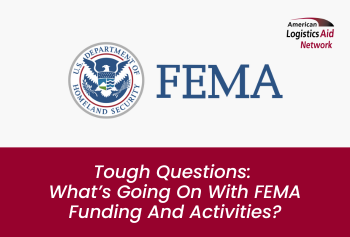Here at ALAN, we try hard to ensure that nothing goes to waste – including the previous experience our talented team members bring to the table. So when we were trying to decide who should spearhead this inaugural Q&A section, it was really a no-brainer.
Meet John Holdsworth, our new resilience programs director. . A longtime emergency management professional, he comes complete with the ability to make his own hot sauce – and the cool head needed to field hot seat questions like these.
Lately there seem to be so many FEMA-related changes that I can’t even begin to keep them straight. Any chance you can help me out by explaining them in plain English?
Given all of the dramatic developments over the past four months, this is the $64,000 question that’s on almost everyone’s minds, at least if they care about the state of disaster preparedness and response.
The short answer is we’re seeing an overarching shift towards greater state, local and private sector responsibility for managing disaster risk and recovery – and a huge push for emergency management reform at the federal level.
Meanwhile FEMA will be focusing its resources on catastrophic events and life-saving operations. Ultimately, the current administration is looking to change how – and how much – the federal government pays for disasters. And in this case how much equals less.
Including, we assume, financial resources?
You’re catching on quickly. Yes, the current administration is looking to change how –and how much – the federal government pays for disasters. And in this case how much equals less.
Obviously this evolution has already begun, because we’ve already seen the start of significant FEMA staff reductions as well as several seesawing changes to federal grant funding and disaster declarations being declined.
But it’s nowhere near to being complete. Among other things, we’re waiting to see what kinds of recommendations emerge from the FEMA Review Council that the administration created. And there are rumors of major long-term changes by the start of the federal fiscal year in October.
What will this mean for this year’s hurricane season?
During the upcoming hurricane and wildfire season, federal resources will be focused on immediate life-saving operations and support for only the largest, most complex disasters. For most other events, the primary responsibility will rest with state, local, territorial or tribal entities.
I probably don’t have to tell you that this has many members of the disaster relief community concerned.
What are some of their biggest concerns?
In most cases the expectation that state, local, territorial or tribal entities will be ready to immediately take on these responsibilities isn’t realistic or reasonable. It can take years to do a good job of assessing and prioritizing risks, identifying resource needs and developing coordination and contingency strategies, and obviously these entities don’t have that kind of time.
Also? There’s still a lot of ambiguity about who will be responsible for some areas of disaster response and relief, like flood insurance, training or incidences of widespread violence, which increases the possibility that those activities could temporarily fall through the cracks.
And of course, there’s going to be less federal funding available to engage in preventive/protective projects like flood mitigation for roads and bridge strengthening, due to the termination of FEMA’s Building Resilient Infrastructure Communities (BRIC).
What are some key takeaways for the private sector?
For one thing, members of the private sector should expect to receive less of the disaster preparedness information that they used to receive, both because local and state authorities have lost the federal grant funding they once had to create it — and because they’re now responsible for so many other activities. So now would be a good time for businesses to enhance their business preparedness, business continuity and supply chain resilience plans.
For another, they should probably be prepared for the possibilities of disruptions in their normal processes and relationships with local, state and emergency managers. In fact, now would be a great time for businesses and associations to check in with their contacts there – before things get too hectic.
Last, but certainly not least, this makes the role of private-public partnerships, which have always been an important part of the disaster relief ecosystem, even more critical – especially for businesses who are involved in the essential movements of goods and services.
One final question: What have these changes meant for ALAN and its work?
ALAN has been working closely with many non-profit agencies as well as our partners in the private and public sector to adapt to these changing conditions and find opportunities to leverage partnerships across the disciplines. And even though we are clearly not looking forward to this year’s hurricane and wildfire seasons – we never are – we do feel heartened by the fact that many agencies and organizations seem to be well- positioned to handle the upcoming season’s challenges based on their preparedness efforts.
That said, we continue to remind our partners that flexibility and creativity will be the name of the game this year.

